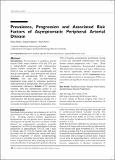| dc.contributor.author | Nikita Mehta, Stephen Ogendo, Mark Awori | |
| dc.date.accessioned | 2020-07-22T07:12:57Z | |
| dc.date.available | 2020-07-22T07:12:57Z | |
| dc.date.issued | 2017-01 | |
| dc.identifier.uri | https://repository.maseno.ac.ke/handle/123456789/1525 | |
| dc.description.abstract | Introduction: The prevalence of peripheral arterial disease (PAD) ranges between 4.5% and 57% and is independently associated with cardiovascular disease burden irrespective of symptoms. Two thirds of cases are thought to be asymptomatic and may go unrecognised. Local prevalence and natural progression of asymptomatic PAD is unknown.
Methods: This one year, non-interventional longitudinal study, aimed to determine prevalence and progression of asymptomatic PAD in patients with cardiovascular risk factors.
Results: Of 217 patients screened, 36% had asymptomatic disease in 113 legs. Of sixty two who returned for follow-up, eight normal legs developed asymptomatic PAD, and 46%, asymptomatic at baseline showed disease progression. Initial baseline ABI showed significant change over 1 year of follow-up (p=0.001) and 21% (13) of patients eventually developed intermittent claudication. Also, 52% of baseline asymptomatic participants having at least one associated cardiovascular risk factor showed disease progression over 1 year. Those developing claudication demonstrated significant ABI deterioration. Having two or more cardiovascular risk factors significantly affected progression of asymptomatic disease, (p = 0.031).
Conclusion: Study confirms high prevalence of asymptomatic PAD in our population and significant disease progression in one year. | en_US |
| dc.publisher | The Surgical Society of Kenya | en_US |
| dc.subject | Peripheral Artery Disease, Risk Factors, Asymptomatic, Disease Progression | en_US |
| dc.title | Prevalence, Progression and Associated Risk Factors of Asymptomatic Peripheral Arterial Disease | en_US |
| dc.type | Article | en_US |

